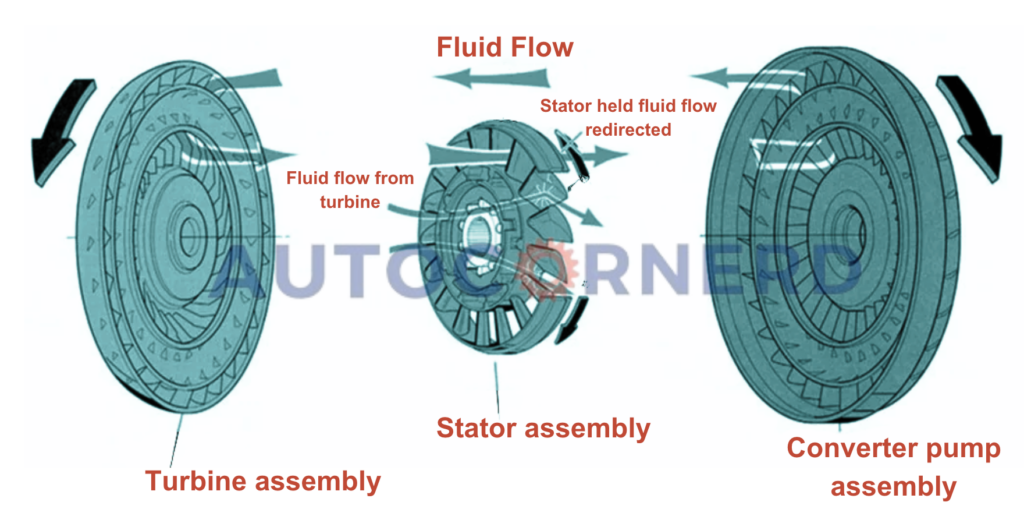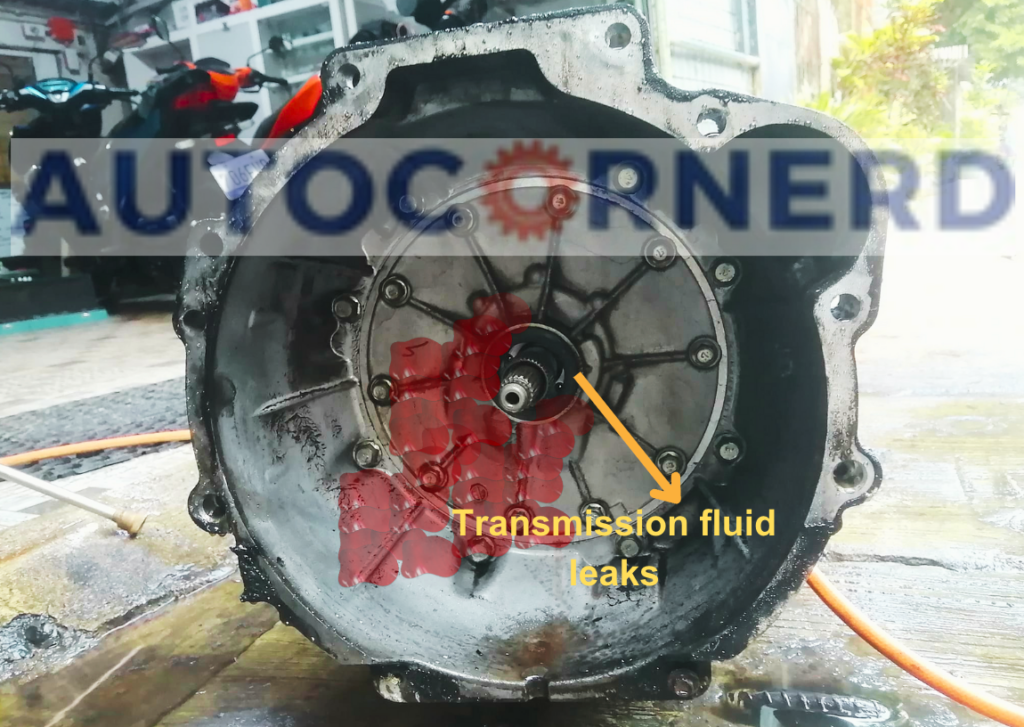Can Transmission Fluid Get Low Without A Leak? [Yes…]
Transmission fluid can get low without a leak. This happens for some inner reasons. A bad vacuum part or seal on the transmission case can make fluid leak into the engine. The transmission fluid gets burned off there. The transmission fluid mixing with the radiator coolant is another reason. This happens when the transmission cooler is damaged. Overfilling the transfer case pushes transmission fluid out through the input seal. Lastly, a leaking front transmission seal allows fluid to pool in the bell housing. The fluid can get flung out while driving here.
Finding your transmission fluid low can worry you. You may wonder how it got low if there’s no leak you can see.
No need to worry – there are some possible reasons. In this guide, we will walk through the common reasons you could have low transmission fluid without a leak outside, and what you can do about it.
You can also read my guide on estimated cost to fix a transmission leak.
How To Check The Level Of A Transmission Fluid?
To check the level of transmission fluid, you should perform the following steps:
- Park a car on level ground.
- Start the car to warm up the engine to an operating temperature as the minimum and maximum marks on the transmission oil dipstick are based on the transmission temperature of around 90ºC to 100ºC. The engine should not be run for more than 90 seconds to warm it up.
- With the engine running, depress the brake pedal and place the gear lever in each gear position, holding for approximately 5 seconds in each position. Then, put the gear lever in PARK.
- Turn off the engine.
- Remove the dipstick from the transmission and wipe it with a clean cloth.
- Insert the transmission dipstick all the way into the transmission.
- Remove the dipstick and check the transmission fluid level.
- If the level of transmission fluid is below the lower mark on the dipstick, it means that the transmission oil level is low.
Note: If the car has been driven for an extended period, at high highway speeds, in city traffic, during hot weather, or while towing a trailer, the transmission fluid must cool down to 90ºC to obtain an accurate reading.
Signs of Transmission Fluid Being Low
Transmission fluid helps to shift gears smoothly by applying pressure on the clutches and bands. If the transmission fluid is low, the gear shifting will be harder, and your car will also make clunking noises due to improper lubrication in the drivetrain.
So, some of the most common symptoms of transmission fluid being low include:
1. Clunking Or Grinding Noises
Low transmission fluid makes clunking or grinding noises. In a car, transmission fluid is used to lubricate the gears of the transmission.
When transmission fluid is low, the gears grind against each other, shift harshly and make grinding sounds. This happens because the gears are not able to rotate smoothly.
Also, due to the low level of transmission fluid, the power is not being smoothly transferred from the impeller (pump) to the turbine in the torque converter, which will also cause clunking noises.

2. Clutch Slipping Or Dragging of Gears
Low transmission fluid can make a vehicle jerky when trying to speed up. The transmission fluid helps apply pressure on the clutches and bands to smoothly shift gears.
When the transmission fluid level is low, there is not enough fluid to put the right pressure on the clutches and bands. So the clutches slip, and the gears do not shift smoothly. Also, low transmission fluid wears out the clutch pads. The worn pads cannot grip tightly. So they slip when shifting gears.
3. Burning Smell
The burning smell of smoke, plastic, or melting wires means the transmission is overheating or transmission fluid is burning in the engine. This burning smell from the transmission system is usually because there is not enough fluid in the system.
Transmission fluid does more than lubricate the drivetrain and keep the clutches engaged. It also reduces friction and keeps the transmission system cool. If there is not enough transmission fluid, the transmission will overheat. This will cause a burning smell.
4. Check Engine Light
The check engine light may also light up on your car’s dashboard. This happens because the transmission fluid pressure in the automatic transmission is low.
When the transmission fluid is low, the engine may stall. This is because there is not enough lubrication for gears in transmission. This is the main reason the check engine light comes on.
The other reason is that when the engine is running, the ECU sees a problem with the transmission. It sends a warning. You should check the error codes right away using a scanner tool when the check engine light comes on.
The check engine light also comes on for several other reasons. You can read my guide on check engine light diagnosis.
Causes Of Losing Transmission Fluid Without Any Leak
If your engine is losing transmission fluid after driving over a few miles and you aren’t noticing any spot of transmission fluid on a driveway, here are some of the most common causes due to which your transmission is losing transmission fluid without a leak:
1. Bad Vacuum Modulator On Transmission Case
Some very old automatic transmission systems (before 1990’s models) have a vacuum modulator that could fail and cause transmission fluid to suck into the engine.
Older automatic transmissions did not have electronic sensors. They could only be controlled mechanically.
The vacuum modulator is connected to the engine air intake. The vacuum modulator has a diaphragm that is computing the load in your car’s engine.
As you increase the throttle, the vacuum decreases and the vacuum modulator calculates the engine load. This allows the transmission to shift appropriately. As more load is introduced, the engine produces less vacuum and the transmission knows it needs to enter a lower gear.
If the diaphragm of the vacuum modulator is leaking, the transmission fluid will leak through it and burn into the engine’s cylinder with the fuel. This will cause white smoke from car exhaust and will also lower the level of transmission fluid without leakage.
Remove the vacuum line going to the transmission case and see if it is wet inside or if any fluid is leaking out of the vacuum modulator.
2. Leakage Through Transmission Cooler
The transmission cooler sits inside the same radiator that cools the engine. Just like coolant keeps flowing through the radiator to stay cool, transmission fluid also keeps flowing through the transmission cooler. This stops the transmission from overheating.
If the inside wall of the transmission cooler breaks, the high-pressure transmission fluid will mix with the coolant.
If you take off the radiator cap and the coolant looks milky, it likely means transmission fluid is leaking into the radiator. This causes the transmission fluid level go down without any leak.
Also check if transmission fluid leaks through the hoses going in and out of the transmission cooler.
If the cooler hoses are wet, it means the hoses are worn out.
Crimps in the transmission cooler hoses can also block the flow of fluid and stop it from circulating through the transmission.

3. Bad Seal Of Transfer Case
The transfer case is present in four-wheel drives. If the transfer case is overfilled with the transmission fluid, the chances are that transmission fluid is being pushed from the transmission into the transfer case through a transfer case input seal.
Due to that reason, the level of transmission fluid is lowered in the transmission pan.
If you remove the fill plug of the transfer case and the transmission fluid comes running out, it means that the transfer case is overfilled.
4. Leaking Of Transmission Fluid Into Bell Housing

If the front seal of the transmission is leaking, the transmission fluid will settle in the bottom of the bell housing. Bell housing is the part of the transmission system which encloses the torque converter and flywheel.
The transmission fluid pooling in the bottom of the bell housing gets flung out or evaporated upon driving. Due to this reason, transmission fluid level decreases without any noticeable leakage.
A transmission fluid leaking through the front pump seal of the torque converter drips off the bottom of the bell housing, and directly onto the exhaust pipe. As a result, you might notice the cloud of fog following you.
Can Transmission Fluid Evaporate?
The transmission fluid does not evaporate. It sits in a closed box casing of the transmission. But if the fluid leaks out, it can evaporate into the air.
The transmission fluid might leak because:
- The drain plug is damaged.
- The seal of the transfer case doesn’t stop leaks.
- The torque converter leaks.
If your tranny needs more transmission fluid often, it does not mean the transmission fluid turns to air. It likely leaks inside, like through the radiator, transfer case, or bell housing.
Can Transmission Fluid Get Low Over Time?
Yes, transmission fluid gets low over time due to wear and tear or internal leaks.
Transmission fluid helps lubricate the gears and other parts of your engine so they work smoothly. With time, the transmission fluid gets thick due to the buildup of metal particles. This affects the flow properties of the transmission fluid, due to which it seems as if the transmission fluid is lowered.
When transmission fluid lowers, the car will not be able to shift gears smoothly and may stall if you drive over rough surfaces as the insufficient transmission fluid will hinder the transmission process due to a lack of appropriate hydraulic pressure.
It is recommended that you change the transmission fluid every 45,000 to 60,000 miles to prevent this.
If you are not changing the transmission fluid, there will be some buildup inside the transmission. While changing the transmission fluid, you may end up knocking loose some of these deposits, which in turn could block critical valve body passages.
Some First Hand Experiences Shared By Users In Different Communities
Our team conducted research across various online communities, forums, and subreddits to gather user comments and opinions on “Is it possible that transmission fluid getting low without a leak?”
User 1 says:
In my 2020 Tucson, the transmission started to overheat, even with no visible leaks. A friend who’s a mechanic suggested checking the transmission fluid radiator. It was partially clogged, leading to fluid loss through overheating. A good clean-up fixed the issue.
User 2 says:
My 2017 CR-V had a delay in gear engagement. I suspected a leak but found none. My mechanic diagnosed it as a transmission fluid pump issue, causing the fluid level to drop in the transmission while being trapped elsewhere. Fixed the pump, and it’s back to normal.
User 3 says:
In my 2019 Malibu, the gear shifts became rough. Checked under the car, no leaks. The culprit was a bad transmission fluid filter, causing the fluid to circulate poorly and appear low. Replaced the filter, and it’s running smoothly now.
User 4 says:
My 2018 Explorer started making a whining sound during acceleration. No leak on the driveway, but the transmission fluid was low. A mechanic friend suggested it might be a seal issue, where the fluid slowly seeps but doesn’t drip. Replaced a seal and refilled the fluid, and the noise stopped.
